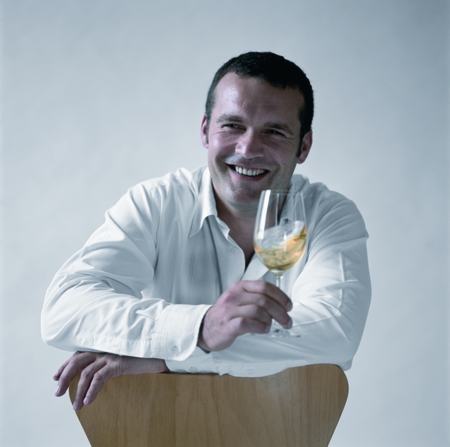Slate means different things to different people. To a geologist it is metamorphosed shale that has been subjected to 270 million years of pressure. To a cultural commentator, it is an online internet magazine owned by the Washington Post. To an artist, a grey colour useful for depicting rainy skies. To a cartoonist, a character from the Flintstones. The first three all applied at Jörg Pfützner’s Slate Tasting of wines grown on slate, held under slate-grey skies last Sunday at Falcon’s Eye, a post modern ex-pat eyrie high above Groot Constantia.
“South Africans don’t drink enough foreign wine” commented Pfützner whose night job is as sommelier at Cape Town’s Aubergine restaurant. Or Riesling in particular, as the varietal is widely punted by wine writers and widely ignored by the drinking public. Although Ernie Loosen from iconic Mosel producer Dr. Loosen does manage to shift 40 000 cases of his entry level Dr. L Riesling to 60 countries and even secured a Business Class berth for it on Singapore Airlines.
The Singapore Airlines selection process is run by Decanter eminence grise Steven Spurrier (hopefully soon to be immortalized by Danny de Vito in a film version of the Judgment of Paris) as a variation on the infamous WINE magazine “seeded player” tastings. Wine labels are awarded points which are then added to tasting scores. Something for WINE managing editor Mike Froud(e) to consider, perhaps?
Loosen sets great store by the slate his vines grow on, for three reasons:
• Reduced fertility results in decreased plant vigour, good news for quality;
• High potassium levels translate to high acid levels in the grapes;
• Slate soils seem to offer natural immunity from the Phylloxera louse with the result that Loosen’s Riesling vines grow on original, rather than American, rootstocks.
Slate would thus also appeal to Douro Boy Dirk van der Niepoort who commented “my objective is to get as much acid as possible” into his wines. “I don’t like a lot of fruit. I want a lot of zingy acidity and freshness.” Something he has undoubtedly achieved in his Vertente 05 and Redoma 05 blend of two dozen varietals that had a stony, iodine character reminiscent of crushed up seashells.
The cultural Slate connection arrived in my in-box. This week Mike Steinberger writes about “the greatest wine on the planet” to whit the Cheval Blanc 47 in one of those fabulous self-aggrandizing stories that are totally meaningless unless you where there. Synchronicity struck, as Cheval Blanc director Pierre Lurton is presumably packing his Louis Vuitton for next week’s release of the 2004 vintage Morgenster wines.
The 47 Cheval is a good example of an anti-slate wine. Grown on a mixture of clay, sand and gravel, the first named contributes opulence (try 14.5% alcohol) while the gravel gives a serious tannic backbone that has supported the whole edifice over the 61 years of its life so far.
With high volatile acidity and some residual sugar, both as a result of a stuck ferment, this is a benchmark Bordeaux that breaks all the rules. After six hours tastings the slate wines of Messrs. Loosen and Van der Niepoort, that the Priorat wines of Swartland surfer Eben Sadie were a no-show, was probably just as well. And as for his fabulous Swartland wines grown on shale, we need only wait another 270 million years for them to qualify for a Slate Tasting.




